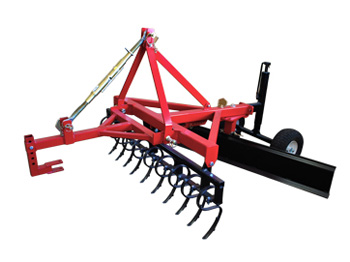Arena Conditioning

As you ask for the trot, your horse gives you the "roller coaster ride'; up and down, with a few trips and inconsistent rhythm thrown in to really make keeping your seat a challenge. While you theoretically want to be able to ride and maintain balance on virtually any riding surface, any rider knows you need a smooth, conditioned surface to get the most out of the time you and your horse spend working together.
So how do you break down the hard clumps, eliminate the deep furrow along the rail or the wall, and level out the uneven ground? Spending hours of hand raking and hosing is like gardening without reaping the benefits. In fact, the next ride brings you right back to square one. Homemade drags can work well on the surface, but generally don't do much to eliminate clumping or uneven areas. If you spend any significant amount of time in your practice arena, a track and ring conditioner is one of the best investments you can make. This single piece of equipment used with your tractor or all-terrain vehicle will turn your arena, or schooling area, into your favorite place to train or ride.
Track and ring conditioners are specifically designed to grade and smooth the arena surface, all at the same time. A good quality unit can be adjusted, so it can be used to drag footing or "float" on the surface, leveling as you go. Look for agricultural 'S'-tines that can grade to as many as six different depths, and a strong blade with the ability to change pitch and angle. This allows you to get next to the rail or wall and pull the footing away towards the inside of your arena. Heaped or sunken corners can be eliminated. Also look for a unit that's powder-coat painted for a highly durable finish.
Using a track and ring conditioner can cut about two-thirds of the time and labor required to keep your arena in tip-top riding condition. Evaluate the sizes available (six foot or eight foot) to determine which best fits your needs. There are even pull-behind units made to use with a four-wheeler, garden tractor or gator. Footing material and depth are also important considerations. Remember, deeper footing will require your horse to work harder and each discipline favors a different footing depth. An approximate footing depth of three to four inches is preferred for flat work and jumpers. Deeper footing is the choice for western riders and ropers. Driving is best with a thinner, fine cushion over a hard surface. Whatever footing depth you choose, be sure not to start out too deep. It is far easier to add footing material than to remove it.
Density and size of footing material is also subject to many variables. Consider how long the footing will hold up before breaking down. Dust can be a common problem with high-use areas. If you are looking at a dirt/sand combination, check with your local gravel company for sand that is "faceted." A faceted sand or mix will hold up longer because it doesn't disintegrate as quickly as regular sand. It also helps to hold off dust for a longer period of time.There are artificial materials to choose from when it comes to footing, such as shredded rubber products (check with your local building inspector for use; some counties don't allow use of this product). This type of footing requires preparation of a more complex base than natural footing material. It will be more costly, but dust is virtually eliminated in the long run.
Wood chip products are another alternative, although you will deal with dust eventually as your 'dirt' base works to the surface. This can be avoided by laying a heavier layer of wood chip footing over a hard surface. This is more costly up front, but easier to maintain. Make sure you have an arena that will allow you to enjoy your precious time with your horse. The benefits of having a well-maintained riding surface really make the difference between a productive training or riding session and a frustrating one.
Happy riding!
 Debbie has over 45 years experience with horses and equine-related businesses. She has owned, trained, boarded horses and run stables at various times in her career. She is a certified fence installer, has given balanced riding lessons, and has shown horses in Western, Western Pleasure, Trail, English, Hunter/Jumper, Fox Hunting, Hunter Trials, Dressage and driving classes. Debbie has been involved in foaling, and just about every aspect of horse ownership possible, and she welcomes your questions and comments. If you are interested in using any articles by Debbie, please send her an email.
Debbie has over 45 years experience with horses and equine-related businesses. She has owned, trained, boarded horses and run stables at various times in her career. She is a certified fence installer, has given balanced riding lessons, and has shown horses in Western, Western Pleasure, Trail, English, Hunter/Jumper, Fox Hunting, Hunter Trials, Dressage and driving classes. Debbie has been involved in foaling, and just about every aspect of horse ownership possible, and she welcomes your questions and comments. If you are interested in using any articles by Debbie, please send her an email.
RAMM Fence Systems, Inc. makes every effort to provide reliable and useful information on horse health, care and products. The statements made on this website are based on years of experience with horses, however, they are based on generalized situations and should not replace diagnosis or treatment by a veterinarian or consultation by a professional. RAMM Fence Systems, Inc. does not assume any legal responsibility. Readers should always consult qualified health care providers for specific diagnosis and treatment.
